Disclosure: Meeple Mountain received a free copy of this product in exchange for an honest, unbiased review. This review is not intended to be an endorsement.
Appetizers
When I was a teenager working under the golden arches, I was shocked how many folks visited the drive thru and ordered trademarked items from other fast food joints. I never understood the disconnect, because I can’t imagine a disappointment greater than pulling into McDonald’s only to be served a BK Whopper. Though if I’m being honest, I wouldn’t complain if they slipped me a chicken sandwich from Chick-Fil-A.
When I sit down to play a game, the box communicates. The components communicate. The rulebook communicates. One of the keys to disappointment, for me, comes when the game communicates something other than what it turns out to be on the table. On the contrary, I love when a game understands itself. Regardless of what is inside the box, there is comfort in knowing that a game delivers on its implicit promises.
Wok and Roll is just such a game from Daryl Chow (Plantopia, Rainforest City) and the folks at Origame. A roll and write game set in an Asian restaurant, Wok and Roll asks players to create dishes with efficiency and speed based on the results of the dice. And it does so with complete consistency.
Lunch Special
Wok and Roll hangs on the activity of six dice, two red and four white, each bearing the icons of five Ingredients and a Recipe book. The Rice, Noodles, Chicken, Broccoli, and Shrimp are well designed and clear as a bell. These will be the ingredients of the game’s various dishes. The game box insert features a bowl into which the dice can fly, but thus far we’ve preferred the ‘ol fashioned tabletop.
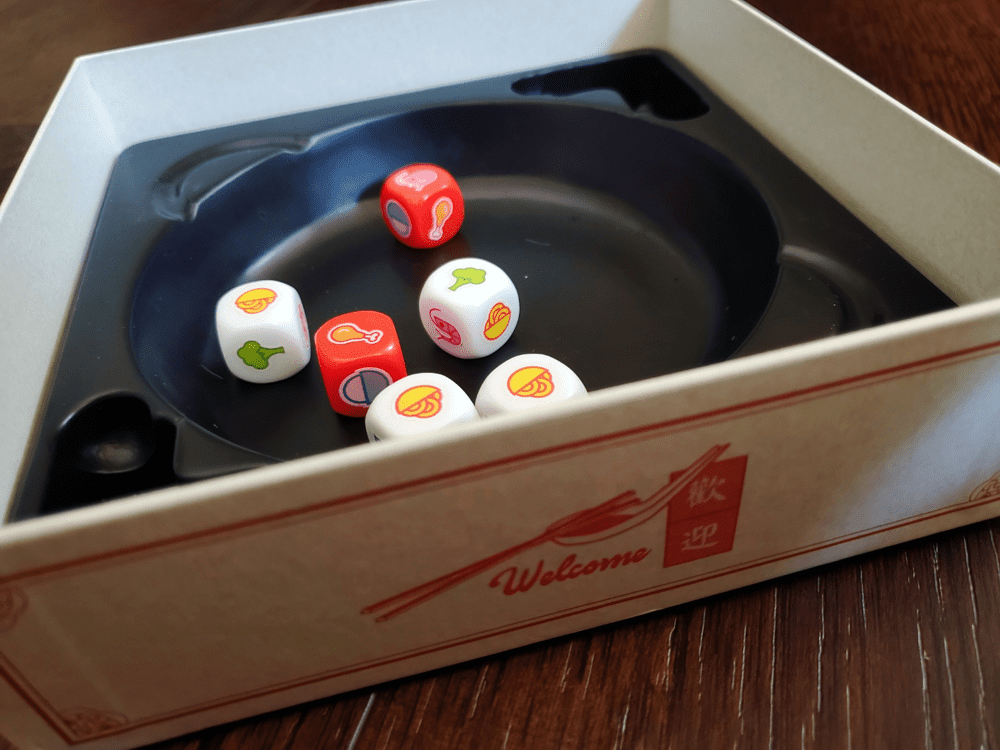
Each player board is two-sided, with a more complex menu on the back for the more daring restaurateurs. For now, I’ll work with the basic front side which offers mostly dishes featuring three ingredients. Players receive a dry erase marker that, unfortunately, will add a sour touch to the game by its dysfunction—unfortunate, but no real surprise in the world of dry erase games—and they’re ready to go!
The rolls are styled after Yaht-zee. The active player rolls all six dice, choosing which to keep for recipes before rolling the others again. After three available rolls, the dice are set and players must choose which ingredients to employ. The catch here is that the red dice belong only to the active player. The four white dice are employed by all, creating sticky situations. And I’m not just talkin’ about the Rice.
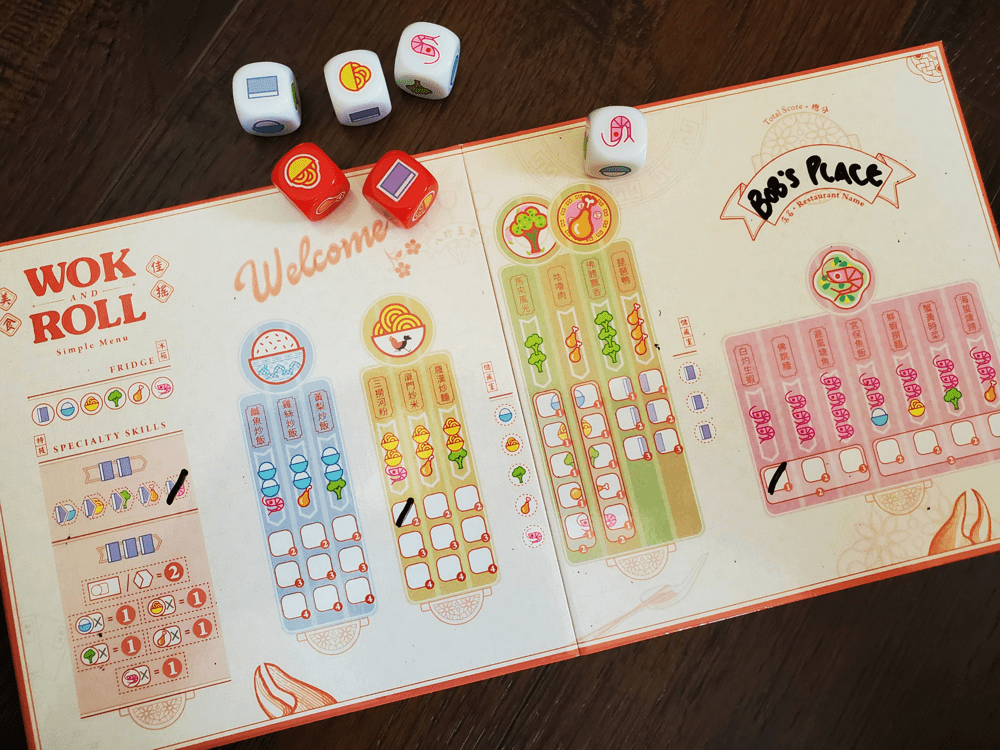
There are three mechanisms in place to mitigate the misfortunes unleashed by the active player and the awkward number of white dice. First, players have a Fridge containing each of the five Ingredients and one Recipe book. These cold extras are available at any time, but each is only available once per game.
Second, the Chicken and Rice menu in the center of the board contains two sets of paired columns that create paired halves of a watermark. When a dish from these columns is claimed, players choose one of the watermarks below. When both pieces of the watermark receive a mark, that Ingredient is unleashed as if it were a Fridge item. This opens the door to all five Ingredients and three of the precious Recipe books.
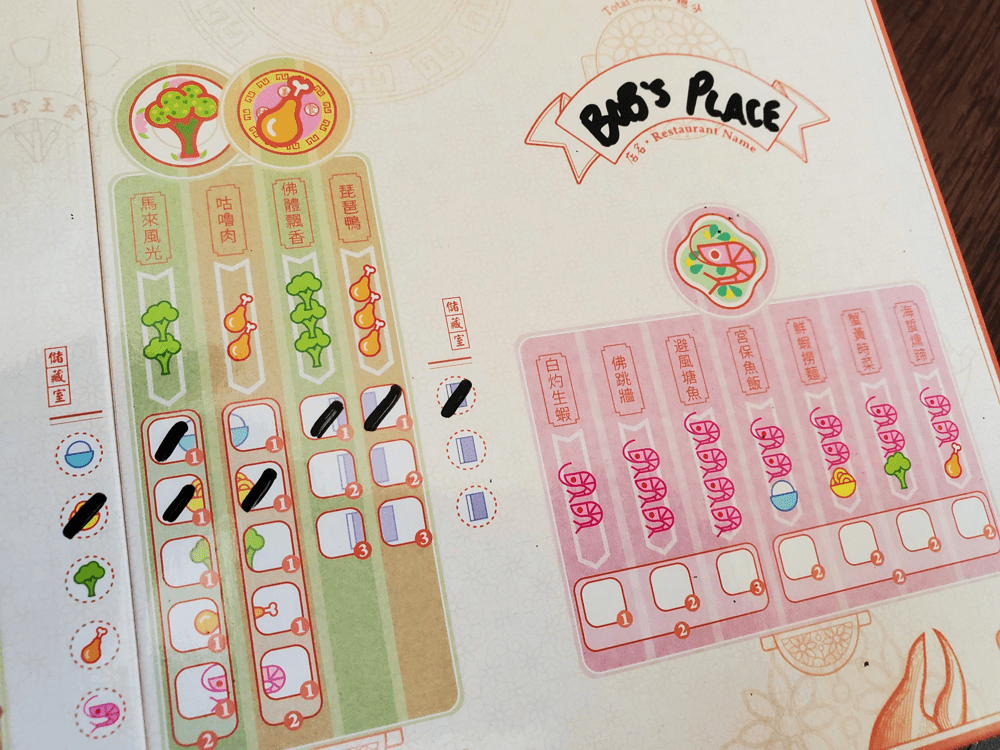
As for those Recipe books, they are potent. Likely, it stems from the fact that they are kept in the Fridge. Two Recipe books unlock Special Abilities that enable future Recipe books to mimic other Ingredients. Three Recipe books unlock endgame bonuses, such as an extra point per Noodle dish created. They are a hot commodity in the restaurant, for sure.
When any player completes three groupings of dishes from the menu, the game ends at the conclusion of that turn. The ending is abrupt enough to make clear the fact that this little menu is, at its heart, a racewalk to the finish.
Chef Special
The backside of the menu is, in feeling if not in concept, a wholly different experience. Aside from a longer run of dishes in each column, three features change the game entirely.
First, and most obviously, Locks are employed along the columns preventing movement until a pair of Recipe books are played to crack open a way. Some of the Locks block multiple columns, others are restricted to just one. No matter, the use of Recipe books shifts completely out of necessity. But the Special Abilities remain, creating a bit of tension as to the best timing and use of the books.
One additional Ability appears on the back: the ability to set one die prior to the first roll. This is a fascinating little gift that can quickly move from a blessing to a curse if the predicted need goes awry. However, it’s far too tempting to ignore!
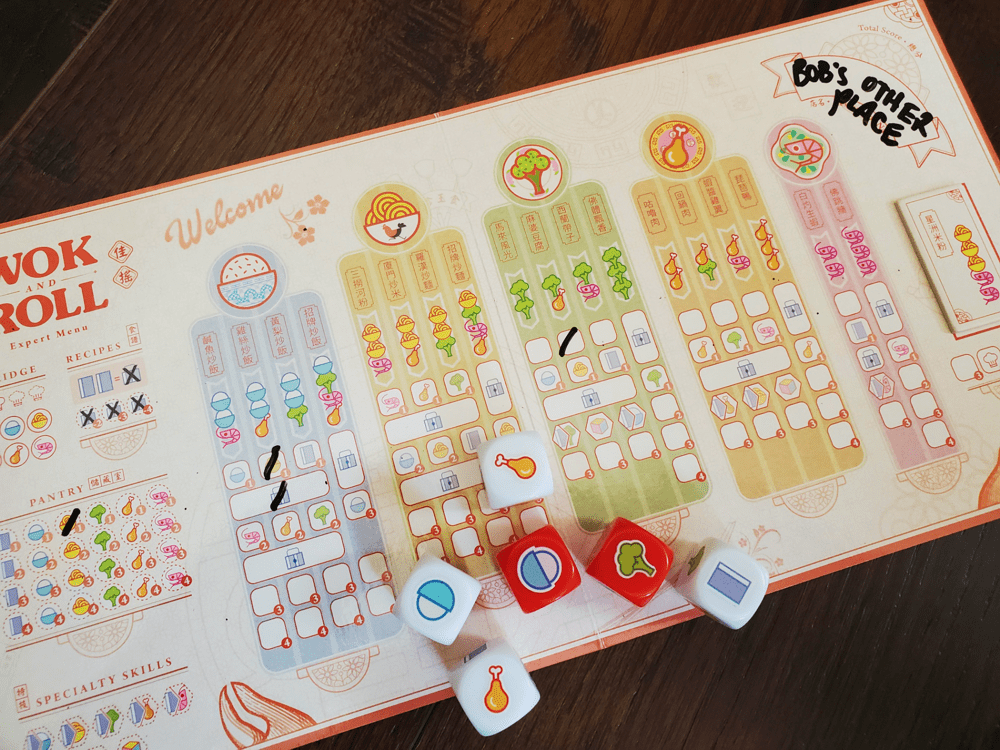
Second, a Pantry has been added in lieu of the various extra Ingredients on the front. Here the Fridge is limited in its capacity, but various dishes across the menu unleash a bonus Ingredient to the Pantry, which is worth points in addition to being available to use in a pinch.
Third, each player receives a unique House Special dish at the beginning of the game, which serves also to unlock additional points and Fridge items.
Otherwise, the game plays the same. However, it’s safe to say this backside is a unique and separate experience in the same Wok and Roll world.
Extras
At a glance, Wok and Roll is almost too simple. The graphics are rather plain. The rules are 100% intuitive. The concept is so real world it’s ordinary. And yet, it works. Inside and out, front and back, the game works. There really aren’t hiccups or missteps to throw the game into a tailspin.
What surprised me is how much more we love the front side than the back. For a family familiar with complexity, you might think we’d use the front side to learn before flipping to the back without hesitation. And we did. We thought we were ready for the real Wok and Roll experience. What we found was that the pace became more deliberate and thoughtful. There’s nothing wrong with that, but we were kinda loving the frantic sprint of the front—especially with the full five players!
The simplicity of the front means every turn palpably matters. There are beautiful decisions in the dice to make sure you capture the specific dishes that will push you to the forefront. Watching your neighbors complete their first and second columns adds pressure to plot an exit stratagem in case the game ends ahead of schedule. Preservation of the Fridge might help, but early use might also work as a tactical consideration! There are tense choices on the front indeed.
Don’t get me wrong, the backside is nice. It adds a layer to the timing as decisions must be made regarding Locks and Special Abilities. The addition of the Pantry is fascinating as Ingredient collection becomes a profitable strategy. The removal of endgame bonuses keeps the focus inside the core mechanics of the menu. The fact that everyone needs the Recipe books on the backside introduces a specific behavior to the restaurant that kicks the game down a gear in terms of anxiety while increasing the intensity.
Mind you, we’re not talking sweat levels of intensity here. This is a lightweight game, but it is also quite comfortable in its own skin—not an ounce of pretense. I can get behind a game that delivers exactly what it promises. Not every game needs to promise brain pain.
My only thematic complaint is the preponderance of dishes with a ratio of two Rice or Noodles to a single Shrimp or Broccoli. If this game is trying to make me hungry, that proportion will have to be reversed. And like most dry-erase games, you’ll want to have a set of good markers around for the moment of inevitable dry out, but that’s the sad norm these days.
Otherwise, brace yourself for straightforward, simple, dice-rolling fun with Wok and Roll.


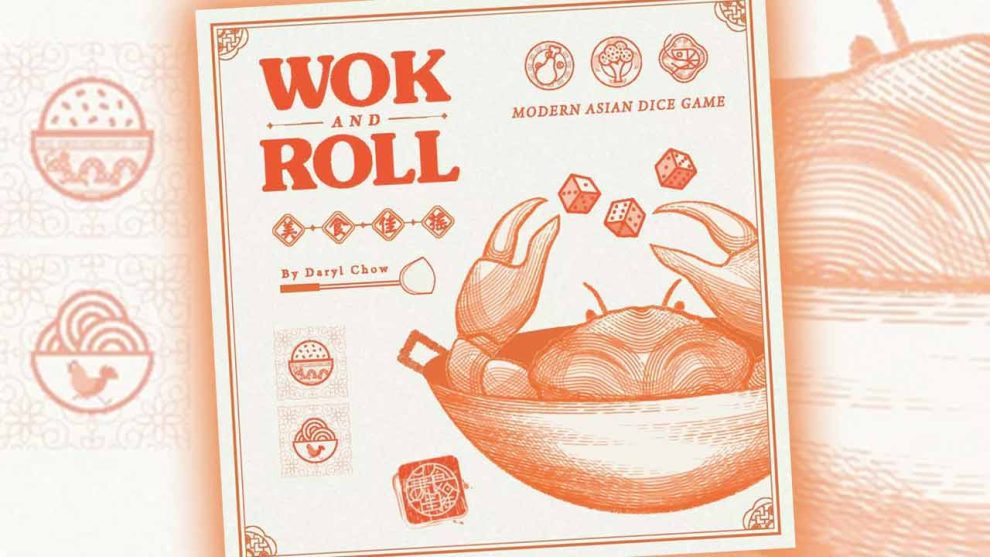








Add Comment